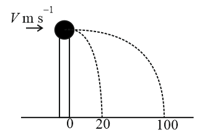Statement-1: Two particles moving in the same direction do not lose all their energy in a completely inelastic collision.
Statement-2: Principle of conservation of momentum holds true for all kinds of collisions.

Important Questions on Centre of Mass, Momentum and Collisions
A ball of mass rests on a vertical post of height . A bullet of mass , travelling with a velocity in a horizontal direction, hits the centre of the ball. After the collision, the ball and bullet travel independently. The ball hits the ground at a distance of and the bullet at a distance of from the foot of the post. The initial velocity of the bullet is

This question has and of the four choices given after the Statements, choose the one that best describes the two Statements.
A point particle of mass moving with speed collides with stationary point particle of mass . If the maximum energy loss possible is given as
then .
Maximum energy loss occurs when the particles get stuck together as a result of the collision.
Three blocks and are lying on a smooth horizontal surface, as shown in the figure. and have equal masses, and has mass . Block is given an initial speed towards due to which it collides with perfectly inelastically. The combined mass collides with , also perfectly inelastically. of the initial kinetic energy is lost in the whole process. What is value of ?

